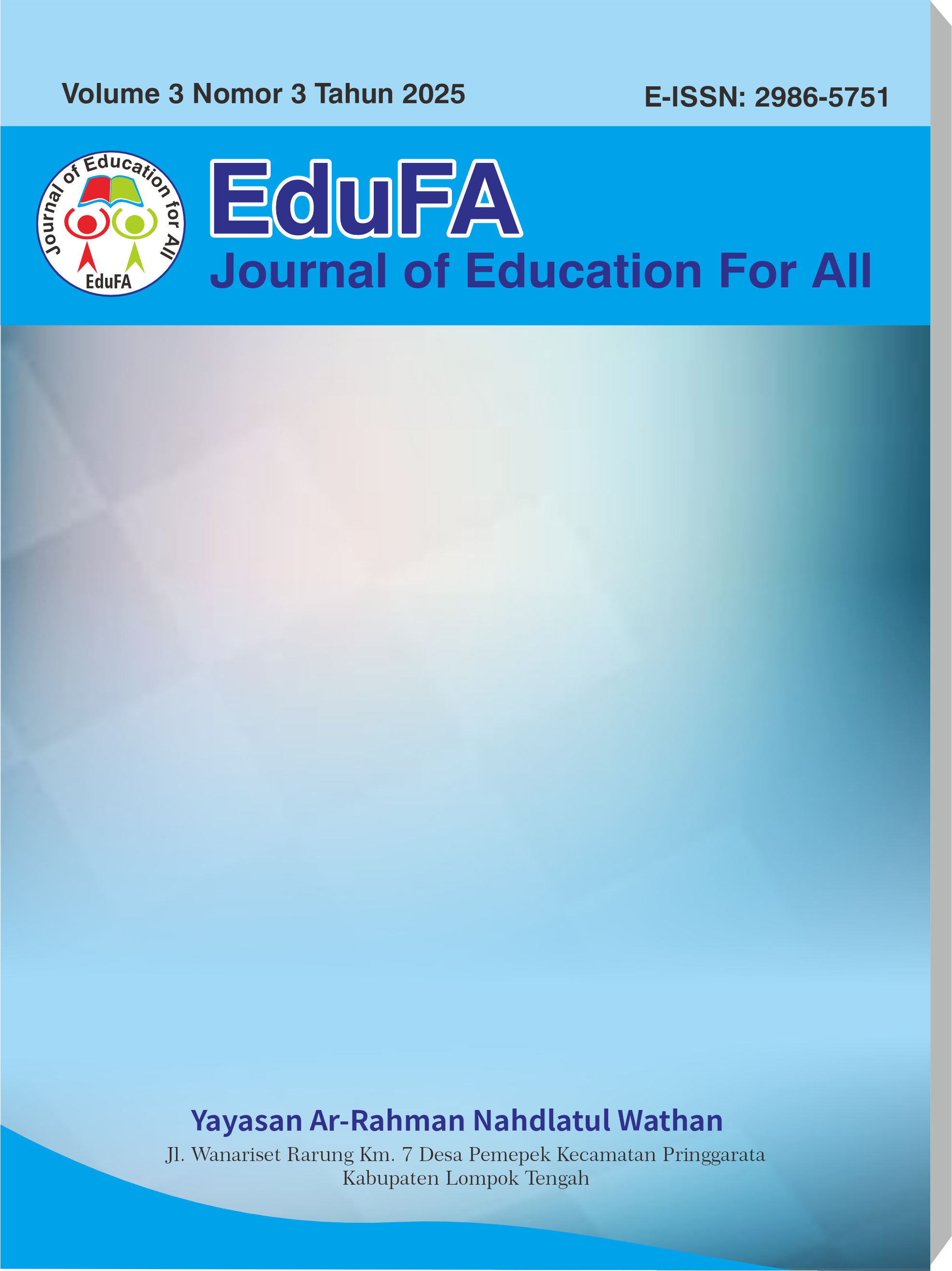Pengaruh Model Kooperatif Tipe Snowball Throwing Terhadap Hasil Belajar Peserta Didik Kelas IV di UPTD SDN Demangan 1
DOI:
https://doi.org/10.61692/edufa.v3i3.242Keywords:
Cooperative learning, Snowball throwing, Learning outcomes, Elementary schoolAbstract
This study aims to determine the effect of the application of the snowball throwing learning model on the learning outcomes of fourth grade students on the area of flat shapes at UPTD SDN Demangan 1 Bangkalan. This research is quantitative research with experimental research type, quasi experimental design and the form used is nonequivalent control group design which means that the experimental sample and control group are not randomly selected. The sample used was 64 UPTD SDN Demangan 1 students consisting of 32 IVB class students and 32 IVC class students. This study used experimental and control classes. The data collected in the form of an implementation observation sheet and pretest and posttest question sheets. The pretest and posttest questions were validated by expert lecturers and tested using validity tests, differentiator reliability tests and question difficulty levels. Data analysis used is a prerequisite test using normality test and homogeneity test. Hypothesis testing using the mann-whitney nonparametric test obtained Sig. (2-tailed) = 0.00 then based on mann-whitney testing criteria if the Sig. (2-tailed) value <0.05 then Ha is accepted and Ho is rejected. So it can be concluded that there is an effect of the application of the snowball throwing type cooperative learning model on the learning outcomes of class IV UPTD SDN Demangan 1 Bangkalan students.
References
Arifin, Z. (2014). Penelitian Pendidikan. Remaja Rosdakarya.
Arikunto, S. (2020). Prosedur Penelitian Suatu Pendekatan Praktik. Rineka Cipta.
Dalyono, M. (2015). Psikologi Pendidikan. Rineka Cipta.
Huda, M. (2015). Model-Model Pengajaran dan Pembelajaran. Pustaka Belajar.
Hudojo, H. (2013). Pengembangan Kurikulum dan Pembelajaran Matematika. IKIP Malang.
Muslim, A., Nur’aeni, E., & Suryana, Y. (2022). Pengaruh Penggunaan Model Pembelajaran Spade Terhadap Hasil Belajar Matematika Materi Perkalian dan Pembagian di Sekolah Dasar. Muhammad Rijal Wahid Muharram Attadib: Journal of Elementary Education, 6(2), 224–236. https://www.jurnalfai-uikabogor.org/attadib
Oktaviani, M. A., & Notobrono, H. B. (2014). Perbandingan Tingkat Konsistensi Normalitas Distribusi Metode Kolmogorov-Smirnov, Lilliefors, Shapiro-Wilk, dan Skewness-Kurtosis. Jurnal Biometrik Dan Kependudukan, 3(2).
Pristiwanti, D., Badariah, B., Hidayat, S., & Dewi, R. S. (2022). Pengertian Pendidikan. Jurnal Pendidikan Dan Konseling, 4(6), 7911–7915. http://repo.iain-
Shoimin, A. (2016). 68 Model Pembelajaran Inovatif Dalam Kurikulum 2013. Ar Ruzz Media.
Sugiyono. (2022). Metode Penelitian Kuantitaif. Alfabeta Bandung.
Sujawerni, V. W. (2015). SPSS Untuk Penelitian. Pustaka Baru Press.
Sundari, S. N., Suryani, D. I., & Kurniasih, S. (2022). Uji Efisiensi E-MagScience Berbasis Flip PDF Professional Tema Makanan dan Kesehatanku untuk Menumbuhkan Kemampuan Berpikir Kritis Siswa SMP. PENDIPA Journal of Science Education, 6, 664–673.
Trianto. (2015). Model Pembelajaran Terpadu. PT Bumi Aksara.
Usmadi. (2020). Pengujian Persyaratan Analisis (Uji Homogenitas dan Uji Normalitas). Jurnal Inovasi Pendidikan, 7(1), 50–62.
Wulansari, A. D. (2023). Aplikasi Statistika Nonparametrik dalam Penelitian. Thalibul Ilmi Pusblishing.
Downloads
Published
How to Cite
Issue
Section
License
Copyright (c) 2025 JOURNAL OF EDUCATION FOR ALL

This work is licensed under a Creative Commons Attribution-NonCommercial-NoDerivatives 4.0 International License.











